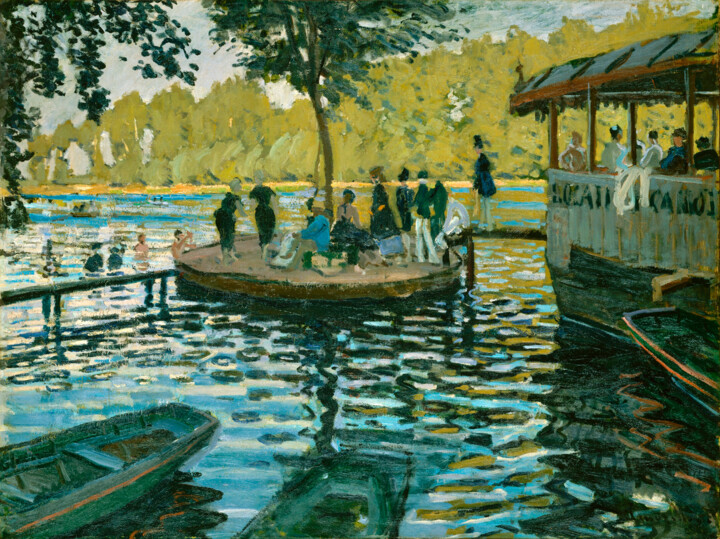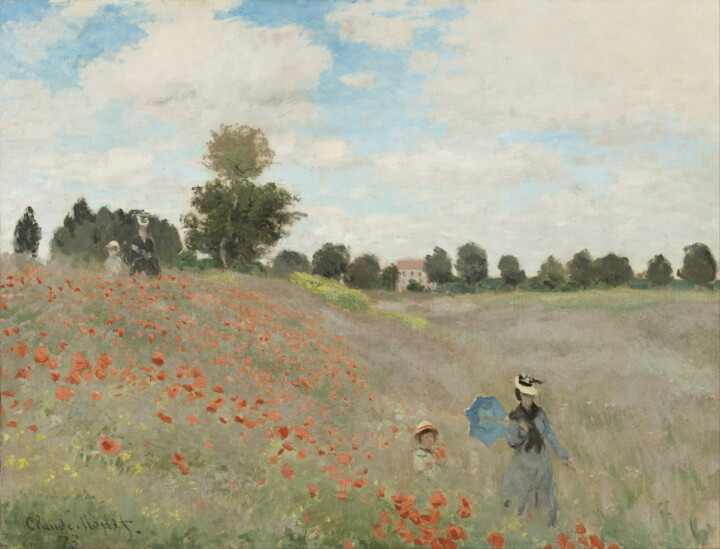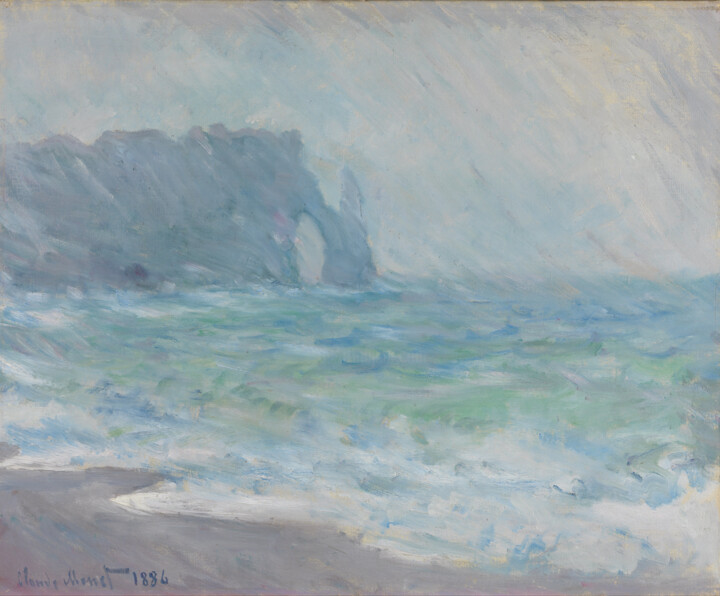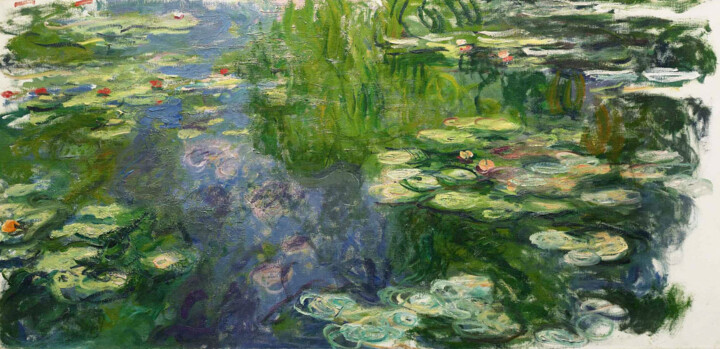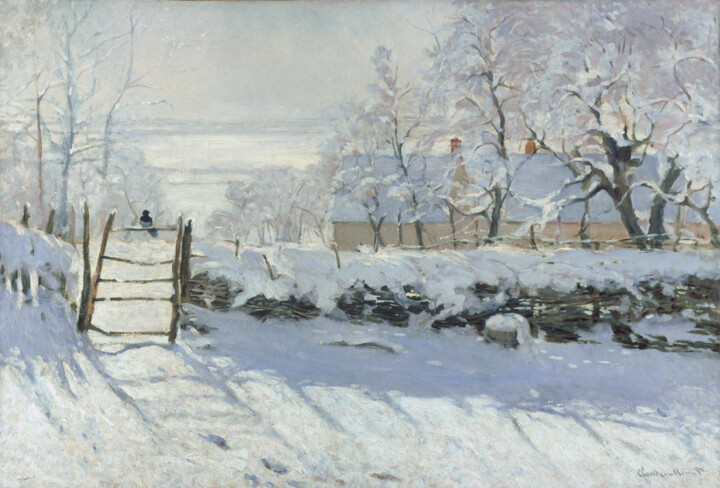 Claude Monet: Impression, Sunrise, 1872. Oil on canvas. 48 x 63 cm. Musée Marmottan Monet, Paris
Claude Monet: Impression, Sunrise, 1872. Oil on canvas. 48 x 63 cm. Musée Marmottan Monet, Paris
Who was Claude Monet?
Claude Monet (1840-1926) was a renowned French painter, who is considered one of the pioneers of Impressionism. His innovative approach to painting and his commitment to capturing the effects of light and atmosphere have had a profound influence on the development of Impressionism.
Impressionism as a whole rejected the strict rules and techniques of academic art. They focused on capturing the "impression" of a scene rather than meticulously replicating it. Impressionist artists, including Monet, Renoir, Degas, and Pissarro, employed loose brushwork, vibrant colors, and an emphasis on capturing the ephemeral qualities of light and movement. They aimed to convey the sensory experience of a moment, often painting scenes of everyday life, landscapes, and urban environments.
The Impressionists faced significant resistance from the art establishment initially but gradually gained recognition and acceptance. Their innovative approach to painting influenced subsequent artistic movements and had a lasting impact on the development of modern art.
 Pierre-Auguste Renoir - Claude Monet, 1875. Oil on canvas. Musée d'Orsay
Pierre-Auguste Renoir - Claude Monet, 1875. Oil on canvas. Musée d'Orsay
Monet's exploration of light and color was a defining characteristic of his work. He aimed to capture the ever-changing effects of natural light and how it influenced the appearance of the subjects he painted. His brushwork became looser, and he used vibrant, unblended colors to create a sense of immediacy and vitality.
Monet prioritized the overall impression and the play of light and color and his paintings often have a sketch-like quality, as he aimed to capture the fleeting moment and the transient nature of his subjects. This approach was epitomized in his famous painting, "Impression, Sunrise," which gave the Impressionist movement its name. Monet's "Impression, Sunrise" marked a turning point in the art world, ushering in a new way of seeing and depicting the world.
Monet's subjects varied widely, ranging from landscapes and seascapes to urban scenes and gardens. He had a particular fascination with water, be it rivers, ponds, or the sea, and he often depicted reflections and the interplay between water and light.
 Claude Monet - The Green Wave, 1866–67. Oil on canvas. Metropolitan Museum of Art
Claude Monet - The Green Wave, 1866–67. Oil on canvas. Metropolitan Museum of Art
Throughout his career, Monet continued to experiment and refine his techniques. He painted a series of works, exploring the same subject in different light and weather conditions. These series allowed him to delve deeper into his exploration of capturing the ever-changing effects of light and atmosphere.
Monet's contributions to Impressionism were not limited to his artistic output. He played a significant role in organizing and participating in the Impressionist exhibitions that challenged the established art world. These exhibitions provided a platform for artists to showcase their works and introduced the public to the radical new approach of the Impressionists.
Claude Monet's unwavering commitment to his artistic vision has made a lasting impact on the art world. His influence on the Impressionist movement and his enduring contributions to modern art are still revered and appreciated in present times.
“Impression, Sunrise”
"Impression, Sunrise" is a renowned painting created by Claude Monet. Completed in 1872, it is considered one of the most influential pieces in the Impressionist movement. The painting depicts the port of Le Havre at sunrise, capturing a fleeting moment with loose brushstrokes and vibrant colors.
The title, "Impression, Sunrise," reflects Monet's intention to convey his personal impression of the scene rather than providing a literal depiction. The term "impression" signifies the fleeting nature of the moment captured by the artist and suggests the emphasis on capturing the sensations and emotions evoked by the subject matter.
The painting features a small harbor filled with sailboats and steamboats, their forms slightly obscured by the mist and the play of light. The sun, depicted as a fiery orange orb, is rising above the horizon, casting a golden glow on the water and the surrounding landscape. Monet used quick brushstrokes and dabs of paint to create an overall sense of movement and atmosphere, allowing the viewer's eye to blend the colors and shapes together.
"Impression, Sunrise" caused a stir when it was first exhibited in 1874, as its loose style and unconventional approach challenged the traditional standards of the art world at the time. The term "Impressionism" itself derived from a critic's sarcastic comment on Monet's painting, which eventually became the name of the entire movement.
 Claude Monet in his studio, c.1920
Claude Monet in his studio, c.1920
Compositionally, "Impression, Sunrise" by Claude Monet demonstrates several key elements that contribute to its unique and innovative portrayal of the scene. The painting features a horizon line slightly above the center of the canvas, dividing the composition into two distinct sections. The lower portion of the painting is dominated by the water, where various sailboats and steamboats are depicted. Their forms are suggested with loose brushstrokes and simplified shapes, blending together in a dynamic and fluid manner.
The upper portion of the painting depicts the sky, where the rising sun takes center stage. The sun is represented as a radiant orange orb, emitting a warm glow that spreads across the sky and reflects on the water's surface. The sky itself is rendered with a mix of soft brushwork and delicate blending, creating a sense of atmosphere and the shifting hues of a sunrise.
Monet's brushwork is loose and gestural throughout the painting, with distinct brushstrokes visible in many areas. This technique lends an energy and vitality to the composition, capturing the essence of movement and the fleeting nature of the scene. The artist's focus on capturing the impression of light and atmosphere is evident in the dabs and strokes of vibrant colors used to depict the reflections and overall ambiance of the scene.
The composition of "Impression, Sunrise" is intentionally unbalanced, defying the traditional notion of a centered and symmetrical composition. The off-centered placement of the sun and the asymmetrical arrangement of the boats create a dynamic tension and visual interest. This composition choice reinforces the idea of capturing a momentary impression, as if the scene is in a state of constant flux.
The overall composition of "Impression, Sunrise" prioritizes the play of light, color, and atmosphere over detailed representation. Monet's intention was to convey his personal impression of the scene, emphasizing the emotional and sensory experience rather than providing a literal depiction. The composition, with its dynamic elements and loose brushwork, contributes to the painting's overall impact and the revolutionary nature of the Impressionist movement.
"Impression, Sunrise" challenged the traditional expectations of composition and technique, pushing the boundaries of what was considered acceptable in the art world at the time. Its innovative approach and compositional choices have influenced countless artists since, making it an iconic and enduring piece in art history.
Socio-Historical Overview of the "Impression, Sunrise"
The painting "Impression, Sunrise" by Claude Monet holds significant socio-historical value, as it not only marked a turning point in art history but also reflected the cultural and artistic climate of the time.
During the late 19th century, the art world was dominated by the academic tradition, which upheld strict rules and standards for painting. Artists were expected to produce highly detailed, realistic works that often depicted historical or mythological subjects.
In contrast, the Impressionist movement emerged as a response to this rigid academic tradition. Impressionist artists sought to break free from these conventions and explore new ways of representing the world around them. They aimed to capture the fleeting and subjective impressions of light, atmosphere, and everyday life.
The exhibition of "Impression, Sunrise" in 1874 provoked a strong reaction among both critics and the public. The loose brushwork, sketch-like quality, and emphasis on capturing the atmospheric effects challenged the established notions of what constituted "proper" art. Critics derided the painting, using the term "impression" sarcastically to imply its unfinished nature.
The controversy surrounding the painting, however, sparked discussions about the nature of art and the role of perception. It led to the coining of the term "Impressionism," which eventually became associated with the entire movement. The Impressionists, including Monet, Renoir, Degas, and Pissarro, began exhibiting their works independently, forming a close-knit group that sought to redefine artistic conventions.
"Impression, Sunrise" and the Impressionist movement as a whole reflected broader societal changes occurring during the 19th century. This period witnessed industrialization, urbanization, and advancements in technology, which brought about significant transformations in daily life and the perception of the world.
The Impressionists embraced these changes and sought to capture the essence of modern life. They turned their attention to ordinary subjects, such as landscapes, cityscapes, and scenes of everyday life, rather than relying on traditional historical or mythological themes. Their emphasis on capturing the effects of light and atmosphere resonated with the changing urban environment and the fleeting nature of modern experiences.
Moreover, the Impressionists' commitment to painting en plein air (outdoors) was facilitated by the availability of portable paint tubes and the development of lighter and more transportable easels. This allowed them to work directly from nature, capturing the immediate sensations and impressions of their surroundings.
The impact of "Impression, Sunrise" and the Impressionist movement cannot be overstated. Their radical departure from academic conventions challenged the established art establishment and paved the way for the development of modern art. The movement's focus on individual perception, capturing fleeting moments, and exploring the effects of light and color continues to inspire artists to this day.
"Impression, Sunrise" serves as a socio-historical landmark, representing the artistic rebellion against traditional norms and reflecting the cultural shifts occurring during the late 19th century. It remains a testament to the transformative power of art and its ability to challenge and shape society.
Monet after “Impression, Sunrise”
After the creation of "Impression, Sunrise," Claude Monet continued to explore and develop the ideas and techniques that emerged from the painting. The success and recognition of the work motivated him to further delve into capturing the transient effects of light and atmosphere in his subsequent artworks.
Monet's focus on the fleeting nature of light led him to experiment with series paintings, where he would depict the same subject at different times of the day or under varying weather conditions. One of his most famous series is the "Haystacks" (1890-1891), where he painted numerous haystacks at different times of day to observe the changing light and color. Another notable series by Monet is the "Water Lilies" (1899-1926), where he extensively explored the reflections and patterns of water lilies on the surface of ponds.
 Monet in his garden at Giverny by Étienne Clémentel, c. 1917
Monet in his garden at Giverny by Étienne Clémentel, c. 1917
Throughout his career, Monet also painted other subjects such as landscapes, urban scenes, and gardens. His series on the Rouen Cathedral (1892-1894) showcased his fascination with capturing the ever-changing light and atmospheric conditions on the façade of the cathedral.
In his later years, Monet turned his attention to his garden at Giverny, where he cultivated a beautiful water garden. He painted extensively the iconic Japanese bridge, water lilies, and the surrounding vegetation.
Claude Monet's legacy extends far beyond "Impression, Sunrise." His continual exploration of capturing the fleeting effects of light and his unwavering dedication to his artistic vision revolutionized the art world. Today, his works are celebrated for their vibrant colors, loose brushwork, and ability to evoke a sense of atmosphere and emotion. Monet's impact on the development of modern art remains profound, and his contributions continue to inspire generations of artists.

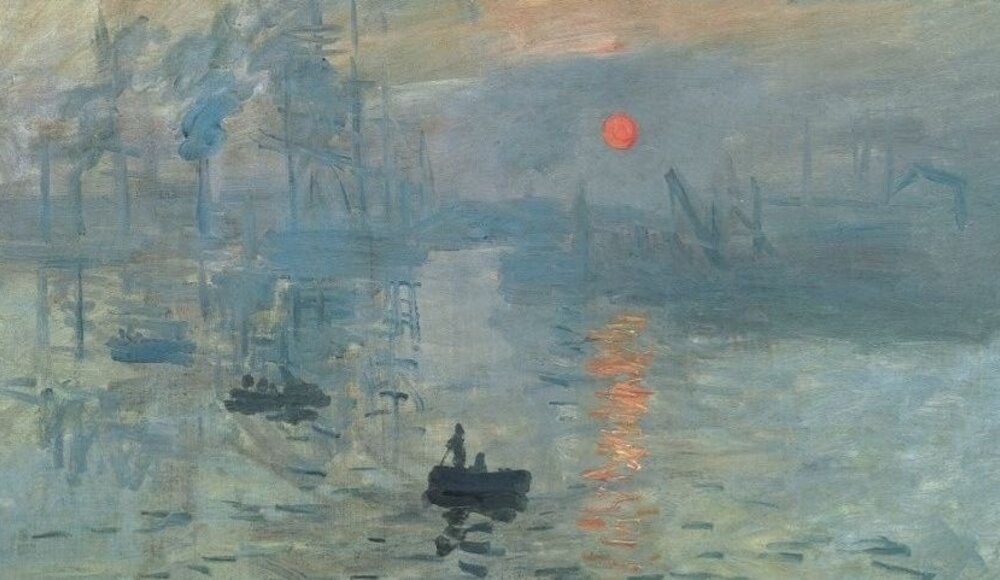
 Selena Mattei
Selena Mattei

